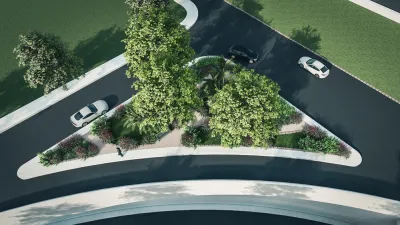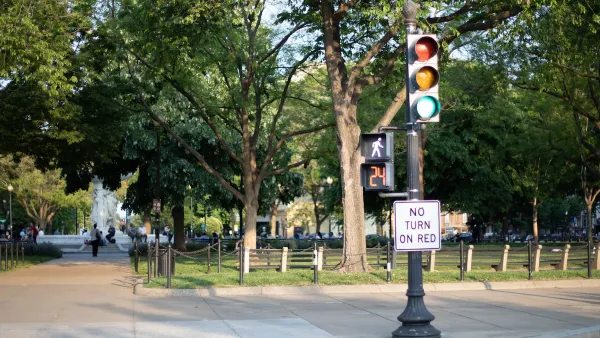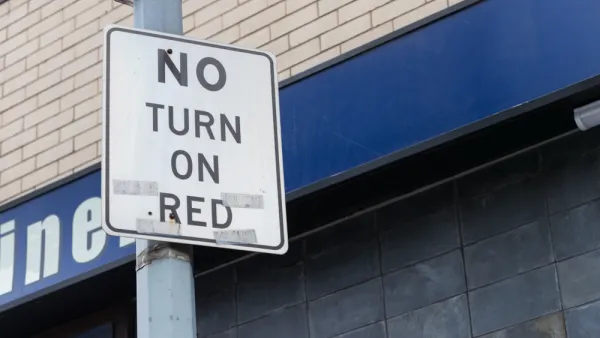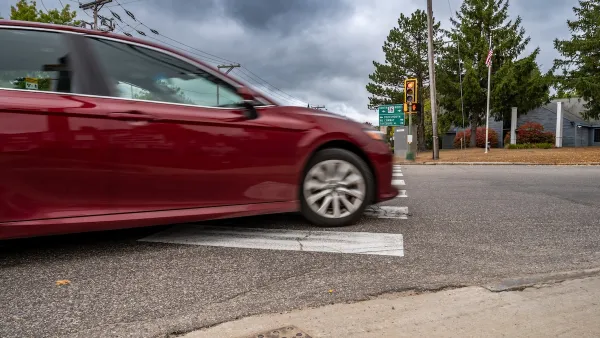Right-turn lanes can make traffic flow more smoothly, but make roadway conditions more dangerous for pedestrians and other road users on non-motorized vehicles.

"There is one roadway design feature that is becoming a point of contention in many communities and you’ve probably driven or walked through one at least once," writes Sam McCrory of the slip lane. Also known as channelized right-hand turn lanes, "Slip lanes are separate turn lanes that allow cars to make a right-hand turn without fully stopping for a red light at an intersection," McCrory explains.
If people driving are allowed to make an unimpeded right-hand turn, engineers believe that congestion will decrease. Slip lanes are also implemented for other reasons, like vehicle safety and consideration for larger vehicles. Slip lanes do help reduce t-bone style vehicle crashes, which are typically more dangerous to people driving; and because of their wide turning angle, slip lanes are more favorable for larger vehicles like semis, emergency vehicles, and delivery trucks to make turns in urban areas.
But there's one significant catch, writes McCrory. Slip lanes "are extremely dangerous for people using non-motorized means of transportation (walking, biking, etc)." According to the article, "In many scenarios slip lanes are completely useless and only cause confusion and negative safety outcomes for people using them. A simple way to increase safety is simply to stop implementing them."
McCrory recommends repurposing slip lane space "for things like bus stops, outdoor seating/gathering places, green space, and other uses," illustrating several potential examples at St. Louis intersections where slip lanes could serve more people-friendly purposes.
FULL STORY: IMAGINING ST. LOUIS WITHOUT SLIP LANES

National Parks Layoffs Will Cause Communities to Lose Billions
Thousands of essential park workers were laid off this week, just before the busy spring break season.

Retro-silient?: America’s First “Eco-burb,” The Woodlands Turns 50
A master-planned community north of Houston offers lessons on green infrastructure and resilient design, but falls short of its founder’s lofty affordability and walkability goals.

Delivering for America Plan Will Downgrade Mail Service in at Least 49.5 Percent of Zip Codes
Republican and Democrat lawmakers criticize the plan for its disproportionate negative impact on rural communities.

Test News Post 1
This is a summary

Test News Headline 46
Test for the image on the front page.

Balancing Bombs and Butterflies: How the National Guard Protects a Rare Species
The National Guard at Fort Indiantown Gap uses GIS technology and land management strategies to balance military training with conservation efforts, ensuring the survival of the rare eastern regal fritillary butterfly.
Urban Design for Planners 1: Software Tools
This six-course series explores essential urban design concepts using open source software and equips planners with the tools they need to participate fully in the urban design process.
Planning for Universal Design
Learn the tools for implementing Universal Design in planning regulations.
EMC Planning Group, Inc.
Planetizen
Planetizen
Mpact (formerly Rail~Volution)
Great Falls Development Authority, Inc.
HUDs Office of Policy Development and Research
NYU Wagner Graduate School of Public Service





























